林徽因英文介绍ppt
- 格式:ppt
- 大小:2.25 MB
- 文档页数:13
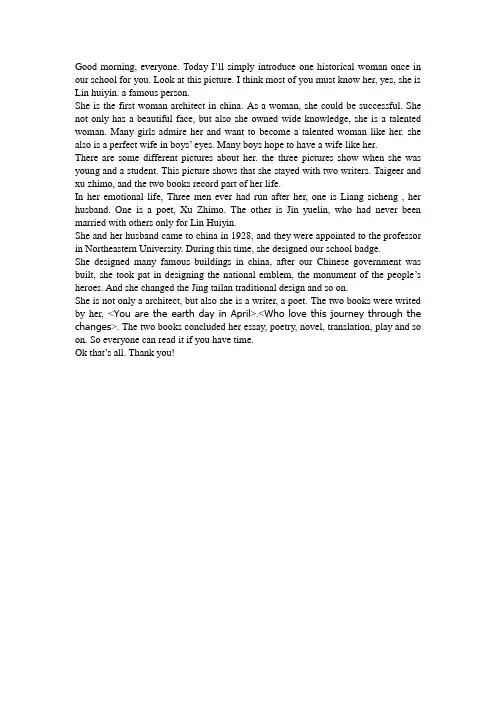
Good morning, everyone. Today I’ll simply introduce one historical woman once in our school for you. Look at this picture. I think most of you must know her, yes, she is Lin huiyin. a famous person.She is the first woman architect in china. As a woman, she could be successful. She not only has a beautiful face, but also she owned wide knowledge, she is a talented woman. Many girls admire her and want to become a talented woman like her. she also is a perfect wife in boys’ eyes. Many boys hope to have a wife like her.There are some different pictures about her. the three pictures show when she was young and a student. This picture shows that she stayed with two writers. Taigeer and xu zhimo, and the two books record part of her life.In her emotional life, Three men ever had run after her, one is Liang sicheng , her husband. One is a poet, Xu Zhimo. The other is Jin yuelin, who had never been married with others only for Lin Huiyin.She and her husband came to china in 1928, and they were appointed to the professor in Northeastern University. During this time, she designed our school badge.She designed many famous buildings in china, after our Chinese government was built, she took pat in designing the national emblem, the monument of the people’s heroes. And she changed the Jing tailan traditional design and so on.She is not only a architect, but also she is a writer, a poet. The two books were writed by her, <You are the earth day in April>.<Who love this journey through the changes>. The two books concluded her essay, poetry, novel, translation, play and so on. So everyone can read it if you have time.Ok that’s all. Thank you!。
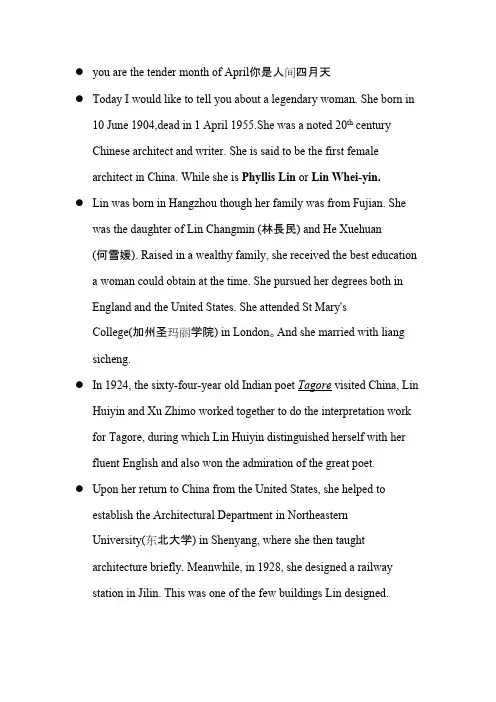
●you are the tender month of April你是人间四月天●Today I would like to tell you about a legendary woman. She born in10 June 1904,dead in 1 April 1955.She was a noted 20th centuryChinese architect and writer. She is said to be the first femalearchitect in China. While she is Phyllis Lin or Lin Whei-yin.●Lin was born in Hangzhou though her family was from Fujian. Shewas the daughter of Lin Changmin (林長民) and He Xuehuan(何雪媛). Raised in a wealthy family, she received the best educationa woman could obtain at the time. She pursued her degrees both inEngland and the United States. She attended St Mary'sCollege(加州圣玛丽学院) in London。
And she married with liang sicheng.●In 1924, the sixty-four-year old Indian poet Tagore visited China, LinHuiyin and Xu Zhimo worked together to do the interpretation work for Tagore, during which Lin Huiyin distinguished herself with her fluent English and also won the admiration of the great poet.●Upon her return to China from the United States, she helped toestablish the Architectural Department in NortheasternUniversity(东北大学) in Shenyang, where she then taughtarchitecture briefly. Meanwhile, in 1928, she designed a railwaystation in Jilin. This was one of the few buildings Lin designed.●After 1949, Lin and Liang Siceng was involved in the design ofthe National Emblem of the People's Republic of China and theMonument to the People's Heroes located in the Tiananmen Square.Lin designed the floral wreath patterns at the base of the Monument to the People's Heroes.●Lin Huiyin wrote poems, essays, short stories and plays. Many of herworks were praised for its subtlety, beauty, and creativity. With her husband she wrote a book named History of Chinese architecture .She also translated English works into Chinese.●She died of tuberculosis. On her monument, it reads, “she is a mother,an architect, a poet.(她是一位母亲,建筑家,诗人) ”●In my eyes, Lin is a perfect female I have ever know about. If I haveto describe her with just three words, they are attractive, talented,clear-headed.。
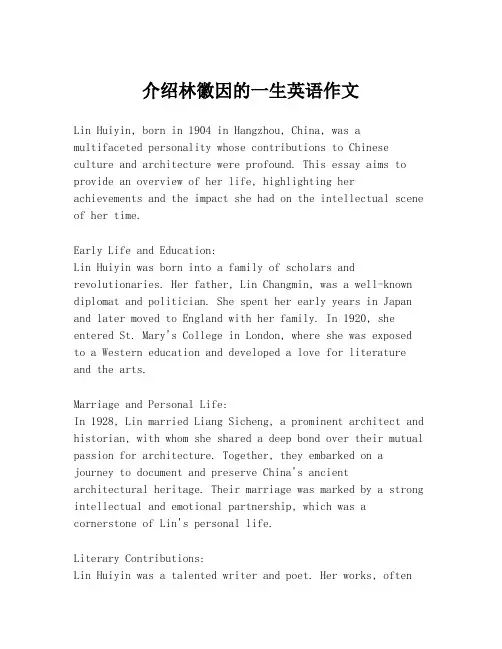
介绍林徽因的一生英语作文Lin Huiyin, born in 1904 in Hangzhou, China, was a multifaceted personality whose contributions to Chinese culture and architecture were profound. This essay aims to provide an overview of her life, highlighting her achievements and the impact she had on the intellectual scene of her time.Early Life and Education:Lin Huiyin was born into a family of scholars and revolutionaries. Her father, Lin Changmin, was a well-known diplomat and politician. She spent her early years in Japan and later moved to England with her family. In 1920, she entered St. Mary's College in London, where she was exposed to a Western education and developed a love for literature and the arts.Marriage and Personal Life:In 1928, Lin married Liang Sicheng, a prominent architect and historian, with whom she shared a deep bond over their mutual passion for architecture. Together, they embarked on a journey to document and preserve China's ancientarchitectural heritage. Their marriage was marked by a strong intellectual and emotional partnership, which was a cornerstone of Lin's personal life.Literary Contributions:Lin Huiyin was a talented writer and poet. Her works, ofteninfused with a sense of melancholy and profound emotion, are considered some of the finest examples of modern Chinese poetry. Her poem "Sheng Si Hen" ("A Faraway Place") is one of her most famous works, reflecting on the themes of life, death, and the passage of time.Architectural Legacy:As an architect, Lin Huiyin played a pivotal role in thestudy and preservation of ancient Chinese architecture. Alongside her husband, she conducted extensive field research, documenting and analyzing various structures. Their work helped to raise awareness and appreciation for China's architectural history both domestically and internationally.Later Years and Legacy:Lin Huiyin's later years were marked by personal tragedy and the challenges of living through the tumultuous times of war and political change in China. Despite these hardships, she continued to contribute to the cultural life of the country. She passed away in 1955, leaving behind a rich legacy that continues to inspire generations of architects, poets, and scholars.In conclusion, Lin Huiyin's life was a testament to her multifaceted talents and her unwavering dedication to boththe arts and the preservation of China's cultural heritage. Her life story serves as an inspiration to many and areminder of the significant contributions women have made to Chinese history and culture.。

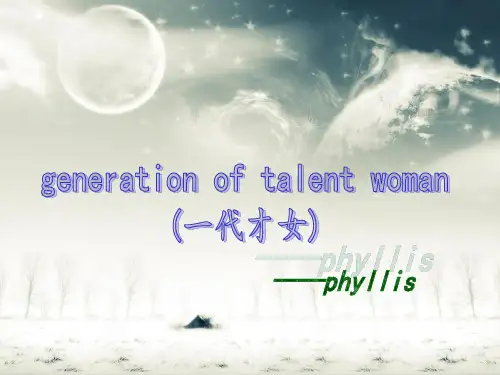

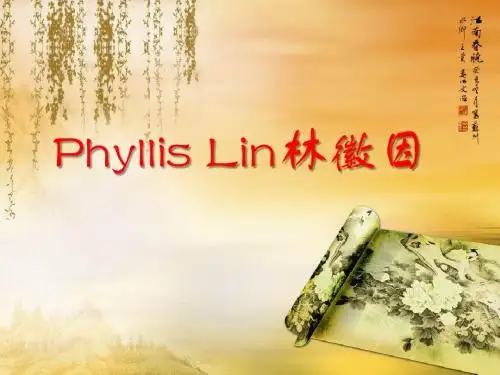

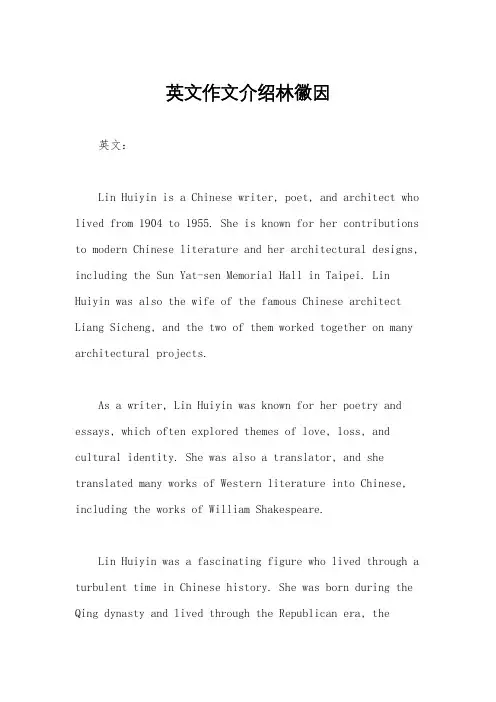
英文作文介绍林徽因英文:Lin Huiyin is a Chinese writer, poet, and architect who lived from 1904 to 1955. She is known for her contributions to modern Chinese literature and her architectural designs, including the Sun Yat-sen Memorial Hall in Taipei. Lin Huiyin was also the wife of the famous Chinese architect Liang Sicheng, and the two of them worked together on many architectural projects.As a writer, Lin Huiyin was known for her poetry and essays, which often explored themes of love, loss, and cultural identity. She was also a translator, and she translated many works of Western literature into Chinese, including the works of William Shakespeare.Lin Huiyin was a fascinating figure who lived through a turbulent time in Chinese history. She was born during the Qing dynasty and lived through the Republican era, theJapanese occupation of China, and the early years of the People's Republic of China. Her life and work reflect the struggles and triumphs of the Chinese people during this time.中文:林徽因是一位中国作家、诗人和建筑师,生于1904年,逝世于1955年。
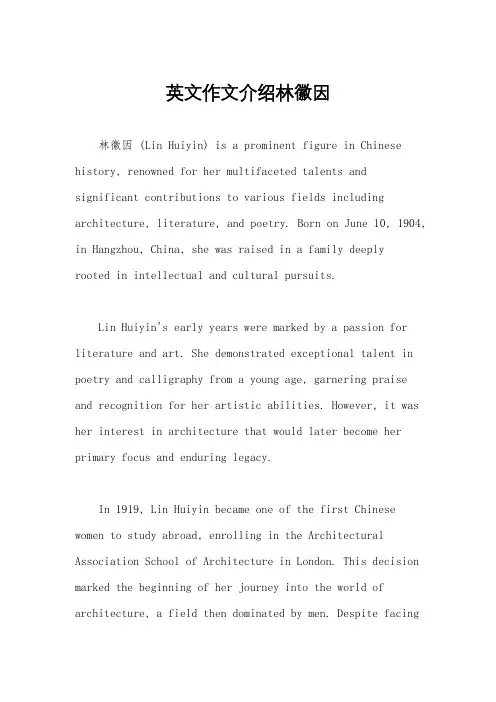
英文作文介绍林徽因林徽因 (Lin Huiyin) is a prominent figure in Chinese history, renowned for her multifaceted talents andsignificant contributions to various fields including architecture, literature, and poetry. Born on June 10, 1904, in Hangzhou, China, she was raised in a family deeplyrooted in intellectual and cultural pursuits.Lin Huiyin's early years were marked by a passion for literature and art. She demonstrated exceptional talent in poetry and calligraphy from a young age, garnering praise and recognition for her artistic abilities. However, it was her interest in architecture that would later become her primary focus and enduring legacy.In 1919, Lin Huiyin became one of the first Chinese women to study abroad, enrolling in the Architectural Association School of Architecture in London. This decision marked the beginning of her journey into the world of architecture, a field then dominated by men. Despite facingnumerous challenges and societal expectations, Lin Huiyin remained undeterred in her pursuit of excellence.Upon returning to China in the early 1920s, Lin Huiyin embarked on a groundbreaking career as an architect, becoming one of the first female architects in thecountry's history. She played a pivotal role in the preservation and restoration of China's ancient architectural treasures, including the renowned city walls of Nanjing and the Great Wall of China. Her tirelessefforts in architectural conservation earned her widespread acclaim and cemented her reputation as a trailblazer in the field.In addition to her architectural endeavors, Lin Huiyin was also a prolific writer and poet. Her literary works often explored themes of love, identity, and cultural heritage, reflecting her deep connection to Chinese culture and history. Through her poetry, she captured the essence of the human experience and left an indelible mark on Chinese literature.Lin Huiyin's personal life was equally remarkable. She was married to the renowned Chinese poet Xu Zhimo, with whom she shared a profound intellectual and emotional bond. Their relationship, though fraught with challenges, was characterized by mutual respect and admiration, serving as a source of inspiration for generations to come.Throughout her life, Lin Huiyin remained dedicated to her ideals and passions, breaking barriers and defying expectations at every turn. Her legacy continues to inspire countless individuals, particularly women, to pursue their dreams and make their mark on the world.In conclusion, Lin Huiyin was a visionary architect, gifted writer, and pioneering feminist whose influence transcends generations. Her contributions to architecture, literature, and poetry have left an indelible legacy that continues to shape Chinese culture and society to this day.。
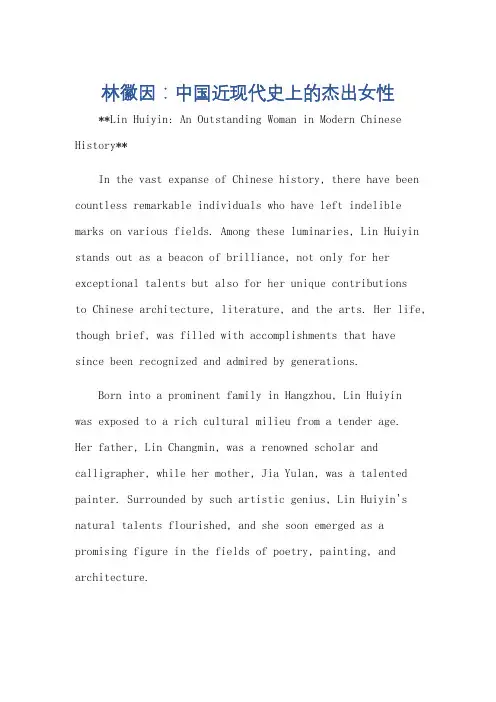
林徽因:中国近现代史上的杰出女性**Lin Huiyin: An Outstanding Woman in Modern Chinese History**In the vast expanse of Chinese history, there have been countless remarkable individuals who have left indelible marks on various fields. Among these luminaries, Lin Huiyin stands out as a beacon of brilliance, not only for her exceptional talents but also for her unique contributionsto Chinese architecture, literature, and the arts. Her life, though brief, was filled with accomplishments that have since been recognized and admired by generations.Born into a prominent family in Hangzhou, Lin Huiyinwas exposed to a rich cultural milieu from a tender age.Her father, Lin Changmin, was a renowned scholar and calligrapher, while her mother, Jia Yulan, was a talented painter. Surrounded by such artistic genius, Lin Huiyin's natural talents flourished, and she soon emerged as a promising figure in the fields of poetry, painting, and architecture.Her interest in architecture was particularly noteworthy. She was among the first Chinese women to study architecture abroad, and her work in this field was groundbreaking. She was deeply influenced by the modernist movement in architecture and advocated for the integration of traditional Chinese elements into modern designs. Her contributions to the design of the National Monument to the People's Heroes in Beijing and the Liang Lin Residence in Suzhou are just two examples of her innovative and influential work.However, Lin Huiyin's legacy extends beyond her professional achievements. She was also a passionate writer and poet, whose works reflect a profound understanding of life and a keen observation of the world. Her poems and essays, often influenced by her travels and experiences, offer a unique perspective on the Chinese landscape and culture. Her writing style, which was both elegant and profound, has been highly praised by critics and readers alike.In addition to her professional and literary pursuits, Lin Huiyin was also a devoted wife and mother. Her marriageto architect Liang Sicheng was a union of two great minds, and together they formed a dynasty of artistic and intellectual giants. Their children, Liang Zhaosheng and Liang Zhaoying, have followed in their parents' footsteps and made significant contributions to various fields.Despite her busy life, Lin Huiyin never neglected her social responsibilities. She was actively involved in various cultural and educational causes, and her dedication to promoting Chinese culture and the arts was unwavering. Her influence and charm extended beyond the confines of her professional circle, and she was widely regarded as a role model for women in China.Lin Huiyin's legacy is not just about her individual achievements, but also about the impact she had on the society and culture of her time. Her work and writing have inspired generations of Chinese women to pursue their dreams and make a difference in the world. She remains a beacon of inspiration for those who seek to blendtraditional values with modern aspirations.In conclusion, Lin Huiyin was a remarkable woman who left an indelible mark on Chinese history. Hercontributions to architecture, literature, and the arts have been recognized and admired by countless individuals. Her legacy is a testament to the power of talent, passion, and perseverance, and her story remains an inspiration for future generations.**林徽因:中国近现代史上的杰出女性**林徽因,这位中国近现代史上的杰出女性,以她的才华和贡献在建筑、文学和艺术领域留下了不可磨灭的印记。